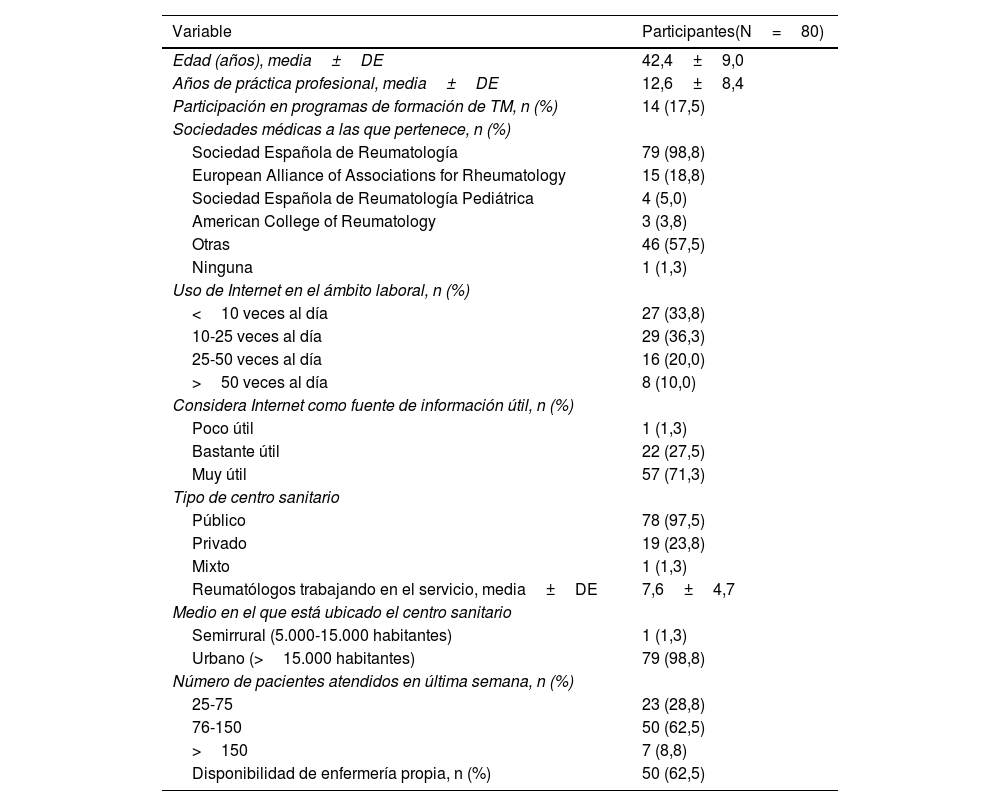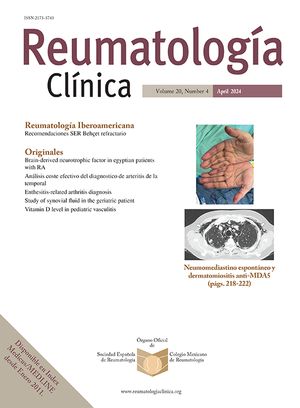Existe un interés creciente en el potencial de la telemedicina (TM) como un medio alternativo a la consulta física. Aunque numerosos estudios prueban los beneficios de la TM en reumatología, no existen recomendaciones sobre su implementación en España. El objetivo de este estudio fue analizar la aplicación de la TM en consultas de reumatología en España.
Materiales y métodosEstudio cualitativo, transversal, multicéntrico con metodología Delphi en 2 rondas de consultas. Se diseñó un cuestionario ad hoc estructurado que incluía enunciados sobre teleconsulta, teleconsulta de enfermería, teleasistencia, telerrehabilitación, telerradiología, teleeducación sanitaria, principales barreras, ventajas e inconvenientes de la teleeducación sanitaria y TM en artritis reumatoide. Los participantes fueron especialistas en reumatología que ejercían su labor asistencial en España.
ResultadosLos reumatólogos participantes (N=80) tenían una edad media de 42,4 (±9,0) años, con 12,6 (±8,4) años de experiencia. Algunos de los aspectos de la TM que obtuvieron un mayor consenso fueron: La TM es útil para el seguimiento de algunos pacientes, ayudar a determinar si es necesaria una consulta presencial, o asistir a pacientes con artritis reumatoide si presentan baja actividad o en remisión; ciertos pacientes, como aquellos en su primera consulta o aquellos que presentan barreras digitales o deterioro cognitivo, deben ser atendidos presencialmente; la TM presenta algunas barreras técnicas y de acceso de los pacientes; la TM puede ser útil en enfermería y en la formación médica continuada.
ConclusionesLa TM puede ser beneficiosa para el tratamiento y seguimiento de los pacientes con enfermedades reumáticas, así como para aliviar la carga asistencial presencial en reumatología.
There is growing interest in the potential of telemedicine (TM) as an alternative to physical consultation. Although numerous studies prove the benefits of TM in rheumatology, there are no recommendations on its implementation in Spain. The aim of this study was to analyze the application of TM in rheumatology consultations in Spain.
Materials and methodsQualitative, cross-sectional, multicenter study with Delphi methodology in 2 rounds of queries. A structured ad hoc questionnaire was designed that included statements on teleconsultation, nursing teleconsultation, telecare, telerehabilitation, teleradiology, telehealth tele-education, main barriers, advantages and disadvantages of telehealth tele-education and TM in rheumatoid arthritis. The participants were rheumatology specialists practicing in Spain.
ResultsThe participating rheumatologists (N=80) had a mean age of 42.4 (±9.0) years, with 12.6 (±8.4) years of experience. Some of the aspects of TM that obtained the greatest consensus were: TM is useful for follow-up of some patients, to help determine if a face-to-face consultation is necessary, or to assist patients with rheumatoid arthritis if they present low activity or in remission; certain patients, such as those in their first consultation or those who present digital barriers or cognitive deterioration, should be seen face-to-face; TM presents some technical and patient access barriers; TM can be useful in nursing and in continued medical education.
ConclusionsTM can be beneficial for the treatment and follow-up of patients with rheumatic diseases, as well as for alleviating the face-to-face care burden in rheumatology.













